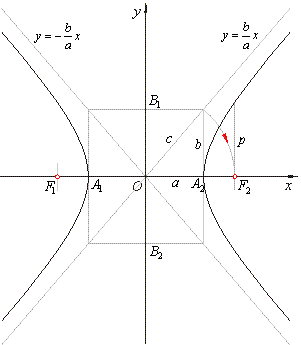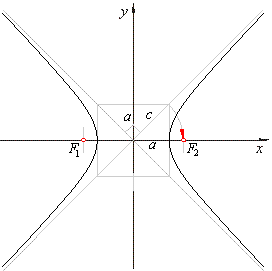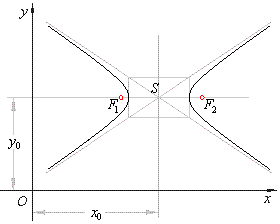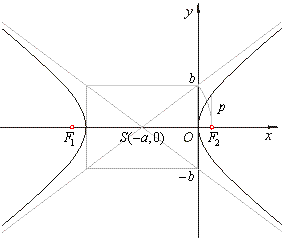|
| Conic
Sections |
|
|
|
|
Hyperbola
|
|
Examining equation of the hyperbola
|
 Equilateral or rectangular
hyperbola
Equilateral or rectangular
hyperbola
|
 Translated hyperbola
Translated hyperbola
|
 Equation of the hyperbola in vertex form
Equation of the hyperbola in vertex form
|
|
|
|
|
|
|
| Examining equation of the hyperbola
|
| The hyperbola is determined by parameters,
a
and
b, where
a
is the semi-major axis (or transverse
semi-axis) and b
is the
semi-minor axis (or conjugate
semi-axis). The intersection points of the hyperbola with coordinate axes we determine from its equation, |
 |
| by
setting, y
= 0
=>
x
= ± a |
| the
hyperbola has intercepts with the
x-axis
at vertices
|
| A1(-a,
0)
and
A2(a,
0). |
| The
segment A1A2
= 2a
is called the
transverse axis.
|
| By
setting, x
= 0
=> y
= ± b·i
there are no intercepts with y-axis.
|
|
Perpendicular to the transverse axis at the midpoint is the
conjugate axis, whose length is
B1B2
= 2b.
|
|
The hyperbola
consists of two branches.
|
|
If we solve the equation of the hyperbola for
y,
|

|
|
 |
|
| it follows that the value of the square root will be real if
| x |
>
a. That is, if the absolute value of
x
is less then a,
then y
is an imaginary number, so that in the interval of x
Î
(-a,
a) there are no points of the hyperbola. |
As the hyperbola is symmetric to both coordinate axes, we can examine behavior of only part of the curve
located at the first quadrant for values of x
>
a. |
| Rewrite the above equation so that it represents only the
positive values of the curve in this interval of x, so |
 |
| Since the value of
x increases and tends to infinity,
x
®
oo
, then the term |
 |
tends to zero, so that |
|
| value of the square root tends to
1
and the equation of the hyperbola changes to |
 |
|
|
| This equation shows that points
of the hyperbola become closer and closer to this line for large values of
x. |
From the above equation of the hyperbola we see that for every value
x
> a, the value of the square root is
less then 1, it means that the ordinate
y
of every point of the hyperbole is less then the ordinate
y’ of the
corresponding point of the line. |
| We also see that as
x
increases, the difference of ordinates, y
and y’ becomes smaller, what means that points
of the hyperbola become closer to this line. |
| |
The
lines, |
 |
are the asymptotes of the hyperbola. |
|
The asymptotes of a hyperbola coincide with the diagonals of the rectangle whose center is the center of the
curve, and whose sides are parallel and equal to the length 2a and
2b, of the axes of the curve, as
shows the above figure. |
| From
the equation of the hyperbola |
 |
for
x
= ± c,
obtained is |
 |
|
| the
semi-latus rectum p. |
| The length of
p can also be calculated from the right triangle with legs
p and
2c,
whose hypotenuse is p + 2a, according to the definition of the hyperbola. |
| |
The latus rectum |
 |
|
|
| are the chords perpendicular to the transverse axis and passing through the foci. |
| The hyperbola which has for its transverse and conjugate axes the transverse and conjugate axes of another |
| hyperbola, is said to be the
conjugate
hyperbola. So the hyperbolas, |
 |
are |
|
| conjugate
hyperbolas of each other. |
| A given hyperbola and its conjugate are constructed on the same reference rectangle.
Thus, they have the common asymptotes and their foci lie on a circle. |
|
| Equilateral or rectangular
hyperbola
|
| The hyperbola whose semi-axes are equal, i.e.,
a
= b |
| has the equation |
x2 -
y2
= a2. |
|
|
| Its asymptotes
y
=
± x
are perpendicular and inclined to the x-axis at an angle of
45°. |
|
Foci of the equilateral hyperbola,
|
|
F1(-Ö2
a,
0)
and
F2(Ö2
a,
0),
|
|
and the eccentricity
e
= c/a
= Ö2.
|
|
 |
|
|
| Translated hyperbola
|
| The equation of a hyperbola translated from standard position so that its center is at
S(x0, y0)
is given by
|
| b2(x
-
x0)2
-
a2(y
-
y0)2
= a2b2 |
| or
|
 |
|
|
|
and after expanding and substituting constants
obtained is
|
| Ax2
+ By2
+ Cx + Dy + F
= 0.
|
|
An equation of that form represents the hyperbola if
|
|
A · B < 0
|
|
that is, if coefficients of the square terms have
different signs.
|
|
 |
|
|
| Equation of the hyperbola in vertex form
|
By translating the hyperbola, centered at
(0, 0), in the
negative direction of the x-axis by
x0
= -a, so that new
position of the center S(-a, 0)
then its equation is |
|
b2(x
+ a)2
-
a2y2
= a2b2.
After squaring and reducing,
|
| b2x2
+ 2ab2x
-
a2y2
= 0 or |
 |
|
| since |
 |
obtained is |
 |
|
|
the equation of the hyperbola in vertex form.
|
|
 |
|
|
|
|
|
|
|
|
|
|
|
|
| College
algebra contents E |
|
 |
|
| Copyright
© 2004 - 2020, Nabla Ltd. All rights reserved. |